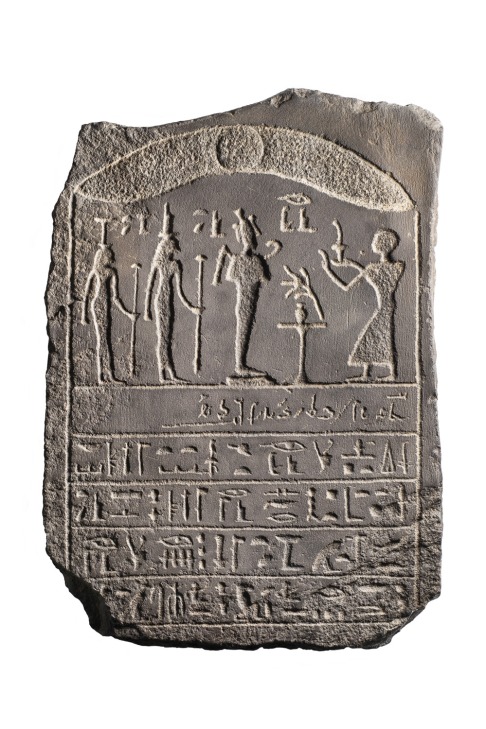https://egyptmanchester.wordpress.com/2020/05/28/texts-in-translation-17-the-stela-of-pawerem-acc-no-8134/
On 05/28/2020 02:29 AM, Campbell@Manchester wrote:
Texts in Translation # 17: The stela of Pawerem (Acc. no. 8134) Although without a certain archaeological provenance, this fine basalt stela (H: 40.5cm) illustrates a concern for commemorations to be legible for eternity. It shows the donor adoring the figures of Osiris and his wife-sister Isis and their sister Nephthys, captioned in hieroglyphs. Although Osiris was increasingly a god worshipped by the living in the First Millennium BC, the character of this stela carries a funerary function too.

Acc. no. 8134. Photo by Julia Thorne (@Tetisheri)
The stela's main inscription opens with a short line in Demotic, the everyday script of Egypt from around Seventh Century BC onwards. This identifies the owner as Pawerem, son of a man called Djedhor and a woman named Tahor. Beneath, the longer text in hieroglyphs gives an offering prayer: An offering which the kings gives (to) Osiris, Foremost of Westerners, Great God, Lord of Abydos, Ptah-Sokar-Osiris, who is in Sha(?)-hetep(?), Isis the Great, Divine Mother, Nephthys, divine sisters doing protection for the Osiris Pawerem, son of Djedhor, born of Ta[hor].
While Demotic script was most likely more easily read by a greater number of people, hieroglyphs provided the age-old magical activation for the words carved on the stela. These explicitly state that the 'divine sisters' – Isis and Nephthys – will act as protectors for the deceased Pawerem as they did for their deceased and reborn brother, the god Osiris. This role is made explicit in a number of funerary motifs, especially during the Late, Ptolemaic and Roman Periods. By associating with Osiris, Pawerem hoped to join in his rebirth. Although the use of Demotic may have made the text easier to read – and therefore to commemorate Pawerem by reading his name aloud – by more people, one wonders if perhaps the Demotic text was a more functional notation to a sculptor to include the correct personal details in hieroglyphic signs.
The stela was acquired in Egypt by a German shipping merchant and émigré to Manchester named Max Emil Robinow (c.1845-1900) and formed part of a significant collection of Egyptian antiquities donated by the Robinow family to Manchester Museum in the middle of the Twentieth Century. Robinow seems to have had a particular taste for items from the Graeco-Roman Period, and it is to this time that the stela of Pawerem should be dated.

Max Emil Robinow
Pawerem's stela is one of more than 100 objects currently travelling in the United States as part of Manchester Museum's first international touring exhibition, 'Golden Mummies of Egypt'. The show is at Buffalo Museum of Science for an extended period, and will open at North Carolina Museum of Art thereafter. A book to accompany the exhibition – Golden Mummies of Egypt. Interpreting Identities from the Graeco-Roman Period (Manchester Museum/Nomad Exhibitions) will be published later this Summer.
-- Sent from my Linux system.
No comments:
Post a Comment